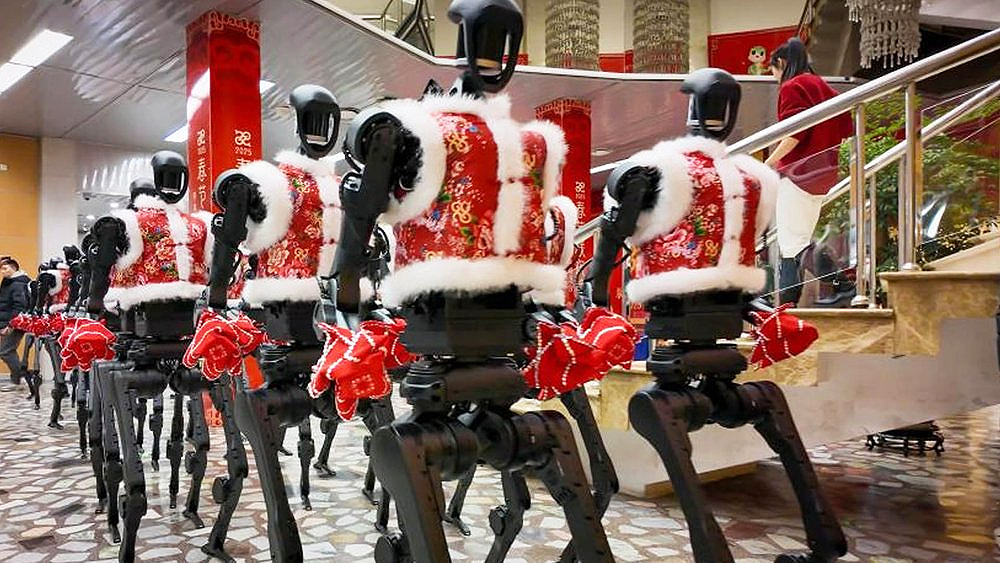
By Mark Tanner*
There are parts of China where you’d be forgiven for thinking you’ve stepped into a sci-fi film set in 2076. Futuristic cityscapes hum with electric vehicles zipping through the streets, people seamlessly paying with a nod, and digital screens flooding every corner with dynamic advertisements. But you ain’t seen nothing yet!
Robots are the next big leap forward
The next step into the future? Robots. And they may arrive sooner than you think.
Anyone who has stayed in a Chinese hotel has likely encountered delivery robots, efficiently bringing meals to guest rooms. Some restaurants are now using robot chefs and servers, preparing and delivering daily staples. On city streets or at trade shows, you might have spotted a ¥9,999 ($1,380) Xiaomi Cyberdog or its successor, the sleek robotic pet offering a glimpse into the consumer robotics future.
But the biggest reason for China’s robotic acceleration isn’t novel or gimmicky, it’s about future-proofing the country.
China’s demographic time bomb: why robots are necessary
With an ageing population and a shrinking workforce, robots are being rapidly developed to fill labour shortages. It won’t be long before they are dominant in factory assembly lines, elderly care homes, and even retail and marketing.
Robotics is a key focus of China’s "Made in China 2025" industrial strategy, with billions being invested in automation and AI-driven machines by both the government and private companies. And as we’ve seen with many manufactured categories in China – mass production = lower costs.
A recent Bank of America study forecasts that China’s robotics industry will mirror its electric vehicle (EV) success, with prices expected to drop 70% to just $17,000 per unit by 2030. As this happens, humanoid robots will shift to the mainstream in China.
Robots are already coming to the fore in China
We caught an early glimpse of this in January’s Spring Festival Gala, where android performers garnered a record-breaking 2.8 billion views. Since then, similar robots have become available for rent on platforms like Alibaba’s Xianyu, costing anywhere from a few hundred to tens of thousands of yuan for use in promotional events, exhibitions, and store openings.
China is poised to become the first mass-adoption market for robots. Just as Chinese consumers embraced mobile payments, e-commerce, social commerce and EVs ahead of the West, they will be among the most open to having robots as part of the marketing mix.
How will robots become relevant in marketing?
Some brands already use robots for backend tasks such as in warehouses and manufacturing. Adoption of this type of robot is becoming increasingly necessary and expected, to ensure swift and cost efficient fulfilment of orders. With the increasing need for personalisation, these robots will need to be integrated with consumer-facing touch points, to fulfil personalised orders that Chinese consumers are increasingly demanding.
At the front-end, the early adoption of robots presents numerous opportunities for branding, customer experience, and storytelling. Yet the use of robots needs to go beyond gimmicky and add value to consumers’ customer journey – whether it be functional or emotional value.
So what next for brands in China?
Due to their tactile nature, robots provide another dimension to connect with consumers beyond virtual influencers, as customers are able to meet them in real life. This can be at exclusive events, to avatars for customer support. It can even be brand ambassadors in store, linked to advanced CRM systems to deliver hyper-personalised service, and respond to emotions like Huawei’s new smartphones.
Chinese consumers embrace brands that push the boundaries of innovation. Brands should run with this and have some fun. At a new whisky launch, a robot bartender could be mixing cocktails while projecting the brand heritage story across the bar. For fashion brands, robotic mannequins can adjust outfits in real time based on store analytics, the weather, or the customer they are speaking to. Robotic brand mascots can engage and entertain consumers with tricks and interactive storytelling.
Brands shouldn’t wait until 2030 to embrace robotics – the technology is already here. Now is a good time to experiment, innovate, and earn consumer goodwill for being ahead of the curve. Those who start now will be better positioned to compete with China’s fast-moving domestic brands both in China and abroad.
Remember, robots aren’t just about backend automation. Chinese consumers are far more open to interacting with AI and robots than those in any Western market. Take advantage of that.
*Mark Tanner is the CEO of China Skinny, a marketing consultancy in Shanghai. This article was first published here, and is re-posted with permission.

We welcome your comments below. If you are not already registered, please register to comment.
Remember we welcome robust, respectful and insightful debate. We don't welcome abusive or defamatory comments and will de-register those repeatedly making such comments. Our current comment policy is here.